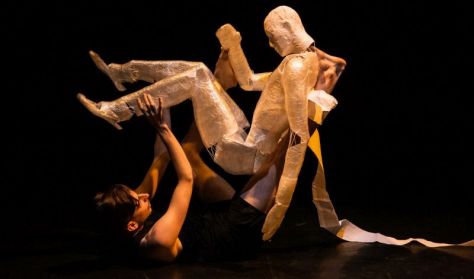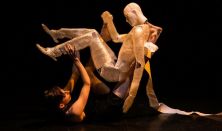Ebben az együttlétben mi töltjük be a passzív fél, a befogadó szerepét, míg a levegő a behatolásból adódóan az aktív félét. Más szempontból éppen, hogy a levegő áramlása tekinthető passzívnak, hiszen az csak leköveti a tüdő aktív mozgását. Egyfelől a levegő van kiszolgáltatva a tüdő munkájának, miközben a tüdő is folyamatos függésben van a levegőtől: annak hiányában végleg leáll. Ezek alapján máris nehezebb meghatározni, mit tekintünk nagyobb aktivitásnak. A behatolásban, vagy a behatolást engedő megnyílásban vagyunk kiszolgáltatottabbak?
Az előadás azt vizsgálja, hogyan befolyásolják a tradicionális férfi-női szerepek egy párkapcsolat dinamikáját. Mennyire rajzolnak ki előre lejátszott erőviszonyokat a társadalom által hagyományosan elvárt szerepkörök? Feltétlenül szükséges két ember kapcsolatában egy dominancia-beli különbség, vagy tudunk valóban egyenrangú felekként találkozni? A heteronormatív szerepek és minták jelenlétét két férfi kapcsolatán keresztül mutatja be, akik látszólag mentesek a nemi szerepek által kirajzolt hierarchiától, mégis nehezen tudnak szabadulni attól. Mindezt a kortárstánc és a bábszínház kettőséből született új forma, a fizikai bábszínház nyelvén.
I realized during a breathing exercise that we are constantly having sexual intercourse with air. It penetrates into our body as we inhale, and recede as we exhale. In this coexistence we fill the passive recipient part, whilst air is the active doer. But from another perspective air can also be considered as the passive participant because it only follows the movements of the lungs. The air is exposed to the lungs, but the lungs are also exposed to air: without air the lungs function no more. On the grounds of this reasoning it’s hard to tell who is more active. Are we more vulnerable during the intercourse, or during the opening which enables the intercourse itself?
The performance examines how traditional male and female roles affect the dynamics of a relationship, and how the conventional roles expected by society predestinate the balance of forces in a relationship. Is dominance inevitable or can we be present as equal partners in a relation? The performance represents the presence of heteronormative roles and patterns through the relationship of two men, who seem independent of the gender role hierarchy. In spite of this apparent freedom, it’s hard for them to get rid of the conventional patterns. Dancing On A Grinder blends the elements of contemporary dance and puppet theatre, creating a new genre called ’physical puppet theatre’.
Fotó: Sín Olivér
Látvány: Kárpáti Panna
Zene: Vranik Krisztián
Dramaturg: Nagy Orsolya
Fény: Váradi András
Konzulens: Fejes Kitty
Rendezőasszisztens: Láng Zsuzsa
Rendező-koreográfus, előadó: Kovács Domokos
Támogatók: Emberi Erőforrások Minisztériuma, Emberi Erőforrás Támogatáskezelő, Nemzeti Kulturális Alap, Manna








